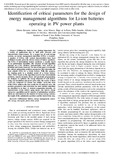Mostrar el registro sencillo del ítem
Identification of critical parameters for the design of energy management algorithms for Li-ion batteries operating in PV power plants
| dc.creator | Berrueta Irigoyen, Alberto | es_ES |
| dc.creator | Soto Cabria, Adrián | es_ES |
| dc.creator | Marcos Álvarez, Javier | es_ES |
| dc.creator | Parra Laita, Íñigo de la | es_ES |
| dc.creator | Sanchis Gúrpide, Pablo | es_ES |
| dc.creator | Ursúa Rubio, Alfredo | es_ES |
| dc.date.accessioned | 2021-02-19T08:12:03Z | |
| dc.date.available | 2021-06-18T23:00:13Z | |
| dc.date.issued | 2020 | |
| dc.identifier.citation | A. Berrueta, A. Soto, J. Marcos, Í. de la Parra, P. Sanchis and A. Ursúa, 'Identification of Critical Parameters for the Design of Energy Management Algorithms for Li-Ion Batteries Operating in PV Power Plants,' in IEEE Transactions on Industry Applications, vol. 56, no. 5, pp. 4670-4678, Sept.-Oct. 2020, doi: 10.1109/TIA.2020.3003562. | en |
| dc.identifier.issn | 1939-9367 (Electronic) | |
| dc.identifier.uri | https://hdl.handle.net/2454/39253 | |
| dc.description.abstract | Lithium-ion batteries are gaining importance for a variety of applications due to their price decrease and characteristics improvement. For a proper use of such storage systems, an energy management algorithm (EMA) is required. A number of EMAs, with various characteristics, have been published recently, given the diverse nature of battery problems. The EMA of deterministic battery problems is usually based on an optimization algorithm. The selection of such an algorithm depends on a few problem characteristics, which need to be identified and closely analyzed. The aim of this article is to identify the critical optimization problem parameters that determine the most suitable EMA for a Li-ion battery. With this purpose, the starting point is a detailed model of a Li-ion battery. Three EMAs based on the algorithms used to face deterministic problems, namely dynamic, linear, and quadratic programming, are designed to optimize the energy dispatch of such a battery. Using real irradiation and power price data, the results of these EMAs are compared for various case studies. Given that none of the EMAs achieves the best results for all analyzed cases, the problem parameters that determine the most suitable algorithm are identified to be four, i.e., desired computation intensity, characteristics of the battery aging model, battery energy and power capabilities, and the number of optimization variables, which are determined by the number of energy storage systems, the length of the optimization problem, and the desired time step. | en |
| dc.description.sponsorship | This work was supported in part by the European Union under the H2020 Project STARDUST under Grant 774094, in part by the Spanish State Research Agency and FEDER-UE under Grants DPI2016-80641-R, DPI2016-80642-R, PID2019-111262RB-I00, and PID2019-110956RB-I00, in part by the Government of Navarra through Research Project 0011-1411-2018-000029 GERA, and in part by the Public University of Navarre under Project ReBMS PJUPNA1904. | en |
| dc.format.extent | 8 p. | |
| dc.format.mimetype | application/pdf | en |
| dc.language.iso | eng | en |
| dc.publisher | IEEE | en |
| dc.relation.ispartof | IEEE Transactions on Industry Applications, 2020, 56(5), 4670-4678 | en |
| dc.rights | © 2020 IEEE. Personal use of this material is permitted. Permission from IEEE must be obtained for all other uses, in any current or future media, including reprinting/republishing this material for advertising or promotional purposes, creating new collective works, for resale or redistribution to servers or lists, or reuse of any copyrighted component of this work in other work. | en |
| dc.subject | Energy management | en |
| dc.subject | Lithium-ion battery | en |
| dc.subject | Microgrid | en |
| dc.subject | Photovoltaic (PV) plant | en |
| dc.subject | Renewable energy | en |
| dc.title | Identification of critical parameters for the design of energy management algorithms for Li-ion batteries operating in PV power plants | en |
| dc.type | info:eu-repo/semantics/article | en |
| dc.type | Artículo / Artikulua | es |
| dc.contributor.department | Ingeniería Eléctrica, Electrónica y de Comunicación | es_ES |
| dc.contributor.department | Ingeniaritza Elektrikoa, Elektronikoa eta Telekomunikazio Ingeniaritza | eu |
| dc.contributor.department | Institute of Smart Cities - ISC | es_ES |
| dc.rights.accessRights | info:eu-repo/semantics/openAccess | en |
| dc.rights.accessRights | Acceso abierto / Sarbide irekia | es |
| dc.embargo.terms | 2021-06-18 | |
| dc.identifier.doi | 10.1109/TIA.2020.3003562 | |
| dc.relation.projectID | info:eu-repo/grantAgreement/ES/1PE/DPI2016-80641-R | en |
| dc.relation.projectID | info:eu-repo/grantAgreement/ES/1PE/DPI2016-80642-R | en |
| dc.relation.projectID | info:eu-repo/grantAgreement/European Commission/Horizon 2020 Framework Programme/774094 | en |
| dc.relation.publisherversion | https://doi.org/10.1109/TIA.2020.3003562 | |
| dc.type.version | info:eu-repo/semantics/acceptedVersion | en |
| dc.type.version | Versión aceptada / Onetsi den bertsioa | es |
| dc.contributor.funder | Universidad Pública de Navarra / Nafarroako Unibertsitate Publikoa, ReBMS PJUPNA1904 | es |
| dc.contributor.funder | Gobierno de Navarra / Nafarroako Gobernua, 0011-1411-2018-000029 GERA | es |


